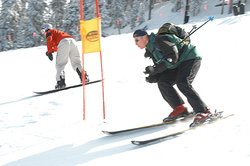Alpine skiing
|
|
Alpine skiing (or downhill skiing) is a recreational activity and sport involving sliding down snow-covered hills with long, thin skis attached to each foot.
Alpine skiing evolved from cross-country skiing when ski lift infrastructure was developed at mountain resorts to tow skiers back to the top of slopes, thus making it possible to repeatedly enjoy skiing down steep, long slopes that would be otherwise too tiring to climb up. Thus, the sport is popular wherever the combination of snow, mountain slopes, and a sufficient tourist infrastructure can be built up, including much of Europe, North America, and Japan.
The main technical challenges faced by skiiers are simply how to control the direction and speed of their descent. Typically, novice skiiers use a technique called the "snowplough" to turn and stop by pointing one or both skis inward, but more advanced skiiers use more difficult but more elegant and speedier methods. These more advanced methods are known as carving. To carve, a skier rolls their knees but keeps the upper body and hips faced down the hill, so that only the knees and feet are turned. This method is far faster and is used by downhill racers.
As skiers gain confidence, they tackle steeper, longer and more uneven slopes at higher speeds. In North America the easiest slopes are marked by green circles, and are typically fairly flat and known as bunny hills. The mid-level difficulty is that of a blue square, and are more challenging but not as much as a black diamond. A black diamond is steeper than a blue square and usually involves challenging terrain. A double black diamond is for experts only, and is very difficult to ski. However, there is no standard for these designations, it is up to each resort owner to determine. So, for instance, a blue-square (midlevel) trail at one ski mountain may be markedly more difficult than a black-diamond (expert) trail at another mountain. In Europe the system is based on colour alone, with the level of difficulty increasing from blue to red to black.
Competitions
Various alpine skiing competitions have developed in the history of skiing, and elite competitive skiers participate in the annual World Cup series, as well as the Winter Olympic Games. Broadly speaking, competitive skiing is broken up into two disciplines: Freestyle and Racing. Racing involves making fast turns around gates in an attempt to get the fastest overall time down a course. Slalom, GS, Super-G, and Downhill are the 4 racing disciplines, with Downhill being the fastest event and Slalom being the most technical. Freestyle skiing incorporates events such as Moguls, aerial acrobatics, and skiier cross.
Competitive skiers often enter the world of competitive skiing through junior-level racing at ages as early as 9, which varies from state to state. Junior racing becomes most competitive at the high school level. A typical high school meet combines slalom, GS (Giant Slalom), and SuperG (Super Giant Slalom). However, in some states, only slalom is raced. The most dedicated and serious junior racers often opt to attend private high schools known as "ski academies", where athletes are exposed to a regiment of physical conditioning, intense ski race training, and conventional schooling. Many national team members come out of such schools. Somewhat outside the domain of the traditional FIS governed events lie newer forms of competitive skiing. Speed skiing involves competitors striving to achieve the highest total speed, with no gates or anything else to worry about. Freeskiing is another emerging sport growing quickly in popularity. In freeskiing competitions athletes start at the top of a usually unskied mountain and ski a route down that involves wide, fast turns as well as cliff drops. The competitors are judged on the technical difficulty of their route and any tricks (such as backflips) that they perform on the way down.
World Cup
Professional alpine skiers compete on the Alpine Skiing World Cup circuit in Slalom, Giant Slalom, Super-G, and Downhill races held at various sites in Europe, the United States, and Canada. Points are awarded in according to where the participant finishes in each individual race. At the end of the season, the personal accumulating the most points from all three race venues is the overall champion.
See also
de:Ski alpin et:Mäesuusatamine fr:Ski alpin it:Sci alpino nl:Alpineskiën ja:アルペンスキー fi:Alppihiihto sv:Alpin skidsport

